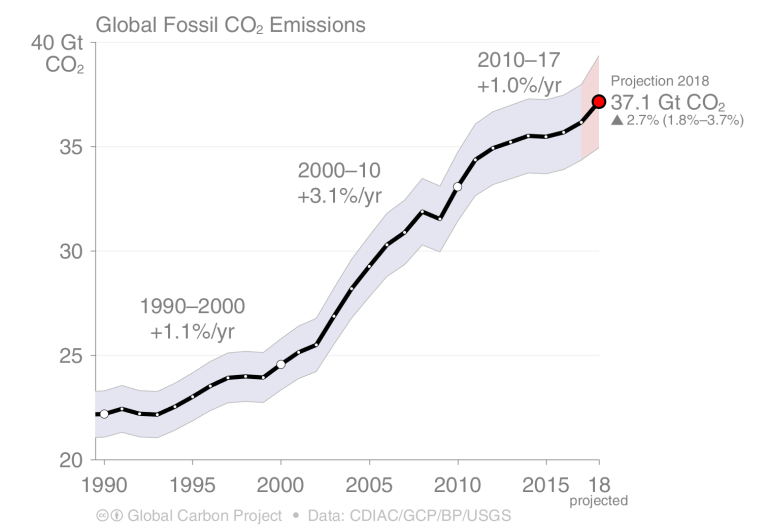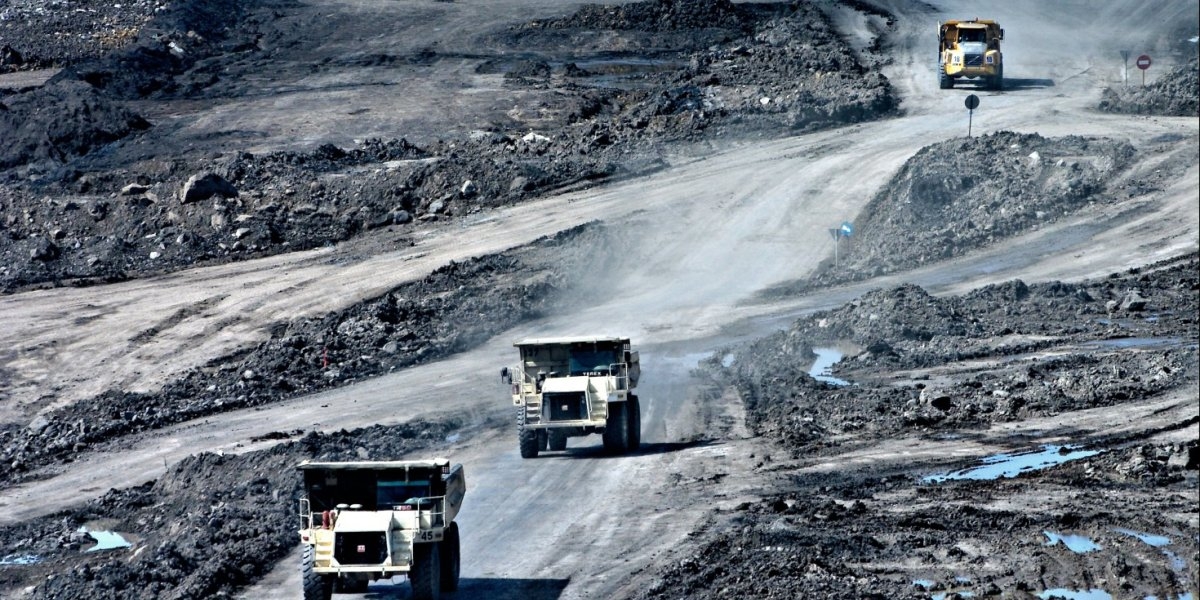MINING FOR EMISSIONS-INTENSIVE COAL IN EAST KALIMANTAN, INDONESIA. A RENEWED GROWTH IN COAL USE IS ONE OF THE MAIN REASONS FOR WHY GLOBAL co₂ EMISSIONS ARE ON TRACK TO RISE MORE THAN 2% IN 2018. PHOTO BY DOMINIK VANYI / UNSPLASH.
Global co₂ emissions rise again in 2018
Global co₂ emissions are on track to rise more than 2% in 2018 on the back of renewed growth in coal use, and continued growth in oil and gas use, according to data released on 5 December.
Emissions rose 1.6% in 2017 after a temporary slowdown from 2014 to 2016, shows the latest data from the Global Carbon Project (GCP).
The Global Carbon Project (GCP) publishes annual analyses of trends in the global carbon cycle, and the data for 2018 is the first full-year estimate of the current year's increase in global carbon dioxide (CO2) emissions.
Global fossil CO2 emissions are projected to grow more than 2% in 2018 due solid growth in coal use – despite a potential peak in 2013 – and sustained growth in oil and gas use.

The rapid growth in low carbon technologies (solar, wind, electric vehicles) are not yet sufficient to peak global emissions, let alone drive emissions aggressively down to meet the “well below 2°C” global warming limit set out by the Paris Agreement to avoid the worst impacts of climate change.
The release on 5 December includes three papers in the journals Nature, Environmental Research Letters, and Earth System Science Data.
More has to be done
Global fossil CO2 emissions (fossil fuels, industry and cement) grew at over 3% per year in the 2000’s, but growth has slowed since 2010, and from 2014 to 2016 emissions only had a very small increase.
“The slowdown in emissions growth from 2014 to 2016 was always a delicate balance, and the 1.6% increase in 2017 and growth in excess of 2% in 2018, clearly demonstrates that more needs to be done to reduce emissions,” said Robbie Andrew, a Senior Researcher at CICERO Center for International Climate Research in Oslo.
The projected growth in carbon dioxide emissions from fossil fuels and industry is +2.7% in 2018, but large uncertainties persist and growth rates between 1.8% and 3.7% are remain possible.
“The growing global demand for energy is outpacing decarbonisation efforts. This needs to change, and it needs to change quickly,” said lead researcher Prof Corinne Le Quéré, Director of the Tyndall Centre for Climate Change Research and Professor of Climate Change Science and Policy at the University of East Anglia, United Kingdom.
“Global commitments made in Paris in 2015 to reduce emissions are not yet being matched by proportionate actions,” said Glen Peters, a Research Director at CICERO.
“Despite rapid growth in low carbon technologies such as solar and wind power, electric vehicles, and batteries, not nearly enough is being done to support policies that limit the amount of carbon dioxide that is put into the atmosphere,” he said.
“The rise in emissions in 2017 could be seen as a one-off, but the growth rate in 2018 is even higher, and it is becoming crystal clear the world is so far failing in its duty to steer onto a course consistent with the goals set out in the Paris Agreement in 2015,” said Peters.
All countries need to share the responsibility
“There is a diversity of countries in the world, and at any time some countries have declining emissions and others increasing emissions, with changes in the global total representing a balance of these opposing forces,” said Peters.
Almost all countries have contributed to the rise in global emissions; either by growth in emissions, or reductions that are slower than expected.
“The continued growth in emissions simply indicates that climate policies are insufficient to overcome the continual upward march of energy use, driven both by the need to develop and the desire to consume ever more,” said Andrew.
“The Paris Agreement put in place strong goals, but – knowing that those goals would not be met in the short term – it also put in place a so-called ‘ratchet mechanism’ to increase ambition over time,” he said.
“To keep the goals of the Paris Agreement in play, the increase in ambition needs to begin now, and at considerable pace,” Andrew said.
Higher U.S. emissions, slower EU reductions
US emissions have declined at 1.2% per year since 2007, but in 2018 a solid increase of around 2.5% [range +0.5% to 4.5%] will break that trend, primarily due to weather conditions requiring more heating in cold months and more cooling in hot months.
It is expected that US emissions will decline again in 2019, indicating that cheap gas, wind, and solar will continue to displace coal.
Emissions in the EU28 fell steadily after 2008 since the Global Financial Crisis led to lower industrial activity and consumption, but emission reductions have stopped since 2014 as the economy recovered.
A slight decline of EU emissions of -0.7% is expected in 2018 [range -2.6% to +1.3%]. In 2018 there has been a slight decline in coal and gas use, but oil continues to show strong growth.
Chinese and Indian emissions growth
China, which drove the unexpected and rapid growth in the 2000’s, was key for the unexpected slowdown in emissions growth from 2014 to 2016, but had an increase in emissions in 2017.
In 2018, emissions are expected to rise +4.7% [range +2.0% to +7.4%], making it likely that China’s emissions have not yet reached their peak.
“There was hope that China was rapidly moving away from coal power generation, but the last two years has shown it will not be so easy for China to say farewell to coal quickly," said Jan Ivar Korsbakken, Senior Researcher at CICERO.
"Coal is likely to dominate the Chinese energy system in the next decade, even if the skyrocketing growth seen in the mid-2000s is unlikely to return,” said Korsbakken.
Despite the rapid deployment in low carbon technologies in India, emissions are expected to grow a solid +6.3% in 2018 [range +4.3% to +8.3%], pushed by strong economic growth of around 8% per year.
Coal is still the mainstay of the Indian economy, and as in China, it will be a challenge for solar and wind to displace coal given the strong growth in energy use.
Emissions in the rest of the world, the remaining 42% of global emissions, are expected to grow 1.8% in 2018 [range +0.5% to +3.0%]. This group is mainly developing countries, and the five countries contributing most to the growth in this grouping in the last decade are Saudi Arabia, Iran, Turkey, Iraq and South Korea.
Emissions growth drives increases in atmospheric concentrations
Global carbon dioxide emissions from fossil fuels and industry will reach around 37.1 billion tonnes carbon dioxide in 2018, a record high. Global carbon dioxide emissions from all human activities (fossil fuels, industry, and land-use change) will reach around 41.5 billion tonnes carbon dioxide in 2018.
Atmospheric CO2 concentration reached 405 parts per million in 2017 on average and is projected to increase by 2.2 ppm in 2018 (+2.0 to +2.6ppm) to reach 407 ppm in 2018.
This increase is near the average of the past decade because of the return to El Niño neutral conditions, but above previous decades due to rising CO2 emissions.
References
Le Quéré et al. (2018): Global Carbon Budget 2018. Earth System Science Data.Figueres, C., C. Le Quéré, G. P. Peters, G. Whiteman, A. Mahindra, D. Guan, et al. (2018): Emissions are still rising: ramp up the cuts. Nature.Jackson, R.B., C. Le Quéré, R. M. Andrew, J.G. Canadell, J.I. Korsbakken, Z. Liu, G.P. Peters, and B. Zheng (2018). Global Energy Growth Is Outpacing Decarbonization. Environmental Research Letters.
